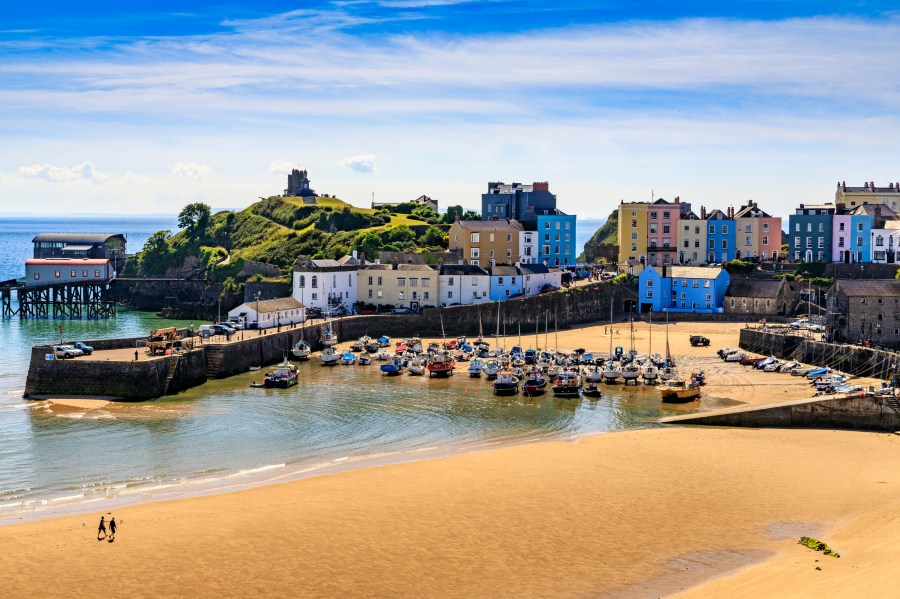CHRISTOPHER NICHOLSON examines the reasons why so many coastal homes are brightly coloured, and picks out a few of his favourite colourful coastal cottages.
The small coastal cottage or large seafront terrace painted in a palette of pastel (or sometimes not so pastel) shades is an increasingly common sight in British holiday resorts and harbours. On a sunny summer’s day they’re a colourful seaside honeypot for tourists.
When these historic dwellings were built their exterior appearance would have been that of natural stone, possibly with a later render or whitewash coating to improve its weatherproofing. The white seaside cottage became a ubiquitous feature of our coastline, but at some unknown point a trend started to paint them in colours other than white.
Exactly why and when this trend started is a bit of a mystery, but it’s likely to date back to Georgian or Victorian times, or possibly even earlier, when a white ‘lime wash’ was applied to exterior walls of new houses. This improved weatherproofing in exposed sites and also hid the variable quality of the stonework beneath. The white wall would also reflect the sun’s rays and was said to keep the temperature inside in summer a little cooler.
Then someone, somewhere then realised that adding the local dried clay to the lime wash produced colours other than white. If you are going to make the effort to paint the exterior of your house every year, then why not paint it a different colour? Depending on the local clay/soil type, this would produce ‘earth’ colours such as orange, pink, brown, yellow, cream or grey which gave the property owners a little individuality in a sea of white.
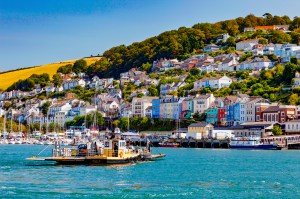
This is probably the source of the widely quoted belief that local fishermen used to paint their houses in different colours to make them recognisable from a distance as they returned to harbour. This story has its roots in an era now sadly long gone, when every small harbour would be full of fishing boats, and their owners would live in the surrounding houses. To be able to pick out your own house as you returned home in a stormy sea or fading light would do much to raise the spirits.
And so it all began, the ‘Great British repaint’ of our coastal cottages and houses. Why do we still do it? That’s a much easier question to answer – tourism. There’s no need for fishermen to be able to recognise their house any more – because there are so few fishermen. Their harbours are filled with yachts, and various other pleasure craft, and their former houses are now colourful and attractive second homes or holiday rental cottages. For most coastal towns and villages today the main ‘industry’ is tourism, and pretty cottages surrounding or overlooking a picturesque harbour are a tourist magnet.
Some local authorities can dictate the actual colour you can paint the outside of your property, particularly if it’s a listed building or in a conservation area. Section 215 of the Town and Country Planning Act 1990 gives local planning authorities the powers to serve notices requiring owners or occupiers to remedy the condition of a property painted an ‘inappropriate’ colour if the authority thinks it adversely affects the ‘amenity’ of the area.
This could account for another variation of this trend I’ve noticed whereby the walls of house remain an innocuous white or a very pale cream, but the window surrounds, porches, guttering, downpipes and doors etc are painted in vibrant colours to give an understated lift to a plain white cottage without making it too incongruous.
Over the years I’ve come across a huge selection of these colourful dwellings on my travels around the British coastline. Here are a few favourite locations that have caught my eye…
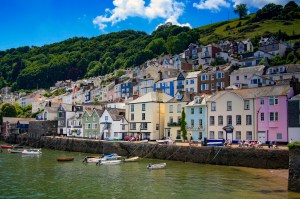
Looking for a coastal property to call your own? Check out the latest properties for sale this month.
For a fine example head for the south Devon port of Dartmouth. Here, on the west bank of the Dart estuary the town houses of Dartmouth rise steeply upwards from the waterfront in rows, one behind the other. Every row is filled with a most appealing mix of pastel shades, at their best when lit by the morning sun.
Even across the river from Dartmouth in Kingswear this theme is continued. When viewed from the north side – that’s the side above the marina – the display is even more vibrant along the terraces of houses on Fore Street overlooking the station. On my last visit the Steam Packet Inn was an eye-catching royal blue. But as you rise above the waterline in Kingswear the more muted pastels take over.
A short drive from Dartmouth along the south coast brings you to the village of Torcross at the end of the lengthy Slapton Sands. Here is a most attractive row of colourful coastal cottages and properties of different ages and eras. Two of them are even thatched. They are located right on the waterline and have suffered a great deal of torment from winter storms that have damaged and flooded most of these houses at some time in the past few years. But on a sunny summer’s day their aesthetic blend of complimentary colours makes them look most appealing.
Cornwall has several hotspots. I would pick out Padstow in particular. Walk up Duke Street away from the harbour to admire the colourful terraces that sweep up towards St Petroc’s church. And on your way look out for No.27 on the left hand side – it’s the thinnest seaside cottage I think I’ve ever come across – but it’s painted a lovely light blue!
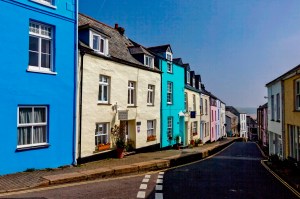
Charlestown was once a thriving china clay port – exporting it all over the world. Nowadays it’s a favourite tourist destination because it’s the home base for an assortment of tall ships, and was a filming location for the BBC’s Poldark series. Looking down on the harbour are a row of former worker’s cottages, now mainly holiday rentals, but their pale cream and yellow walls are complimented by some colourful porches.
Wales has three locations that really should be viewed, one of which shows what can happen when a whole town decides to paint its houses! I’m referring to Aberaeron in mid Wales on the Ceredigion coast. This really is extreme house painting – not just around its attractive harbour, but on into the main streets of the town itself. Some terraces have a harmonious blend of pale colours while others contain some real eye-poppers.
Only a short distance south of Aberaeron lies the former 19th century shipbuilding and fishing port of New Quay (not to be confused with Newquay in Cornwall), and former haunt of Dylan Thomas. Its rows of terraced houses lining the hillsides on either side of the harbour are now attractively painted and lure huge numbers of tourists who also come to look at the resident pod of bottlenose dolphins in Cardigan Bay.
My last Welsh hotspot is the picturesque harbour in the Pembrokeshire town of Tenby. These are not small workers cottages or a terrace of identical dwellings but three- and four-storey Georgian town houses that sweep down the hill from the town square and surround the beautiful harbour at the bottom. It’s quite unlike any of the locations I’ve previously described. The palette here is mainly pale yellows, pinks and blues but the different heights and facades of the houses overlooking the blue water make a most distinctive panorama. It’s the most attractive feature in the whole town and well worth the effort to make a special visit on a sunny day.
Scotland has fewer examples of colourful exteriors than south of the border, but there are a couple of outstanding examples of colourful colourful coastal cottages. Most famous of all is, I suppose, Tobermory – the biggest settlement on the Isle of Mull – whose harbour is completely filled with a kaleidoscope of colour. At the southern end are the smaller hotels and B&Bs, but as you progress along Main Street, past the church and original pier, the shops and buildings increase in size and vibrancy until you arrive at the huge, four-storey terrace of three buildings. The middle one is the Misnish Hotel, now a buttercup yellow but only a few years ago it was black!
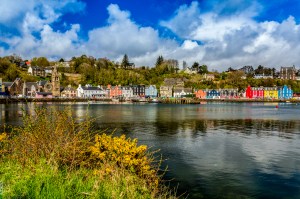
Many of the waterfront colourful coastal cottages in Tobermory are painted in what can only be described as ‘vivid’ colours rather than muted pastels. Bland it isn’t! It’s a striking sight when approaching by boat and the whole array can be viewed at once. And it’s probably the reason why it was chosen to feature in the BBC Children’s series Balamory a few years ago.
There’s a smaller version of the Tobermory effect in another Hebridean island ‘capital’. The harbour at Portree on Skye has a shorter waterfront and terrace of colourful coastal cottages in an almost identical traditional design. They’re set again a backdrop of woodland which make the whole scene look quite bucolic. Only the fuel storage depot at the end of the terrace (even though it’s all been painted green) spoils the overall effect. If you’re ever on Skye, don’t miss the eye-popping yellow of the Portree Independent Hostel on the main road above the harbour.
A couple of other Scottish location that spring to mind are the small village of Plockton close to Kyle of Lochalsh where you can view a historical timeline of coastal house painting. Walk along Harbour Street and you’ll find examples of; unpainted stone cottages, cottages that have been rendered then painted white, cottages where the natural stone has just been limewashed without any rendering first, and quite a few examples of the white cottage with coloured window surrounds, doors and downpipes etc. All in all it’s a very pleasing effect.
On a more wider point, the painting of colourful seaside exteriors doesn’t just apply to the original properties. A lot of new build projects at coastal locations are increasingly adopting the trend and it looks just as attractive on modern building material. The next time you’re in John O’Groats (!) admire the recently refurbished hotel (whitewashed render) and the five spectacular timber-clad holiday cottages are attached to it. They are particularly vibrant and give a much needed lift to what had become a depressing location.
AVOID A BRUSH WITH DANGER…
Beware if you’re considering transforming your house with a colourful exterior. Some of today’s modern high-tech synthetic paint formulations with added fungicides also contain resins which are alleged to affect the ‘breathability’ of the walls and cause moisture to be trapped within the building – something the old fashioned lime washes didn’t. Look for brands claiming to be ‘microporous’ or ‘mineral-based’ to try and avoid this.

